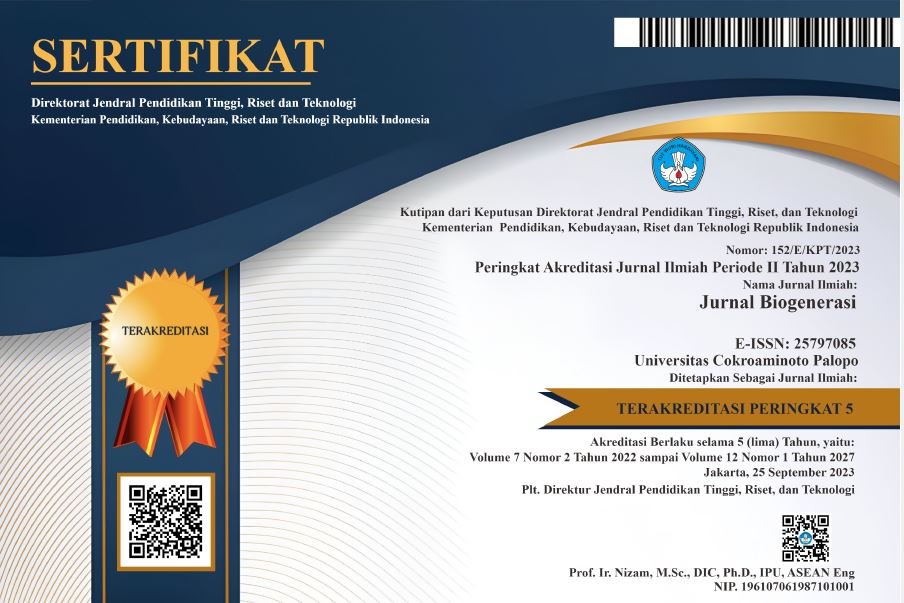PEMBUATAN TEH KOMBUCHA BERBAHAN DASAR TEH HIJAU
DOI:
https://doi.org/10.30605/biogenerasi.v10i2.5766Keywords:
kombucha, green tea, pH, organoleptic properties, scoobyAbstract
Kombucha tea is a very interesting traditional drink because this tea is the result of fermentation carried out by a symbiotic culture. The symbiotic culture is SCOOBY (Symbiotic Culture Of Bacteria And Yeast). The tea that can be used is green tea. Green tea contains compounds such as tannins, caffeine, flavonols, flavonoids, alkaloids and saponins. Different types of tea can affect the color of the kombucha. The fermentation time for kombucha tea is 7-14 days. Fermentation time can affect the degree of acidity and physical properties of kombucha tea. This research is a descriptive study which aims to determine the pH and organoleptic properties, namely taste, aroma, color and how to make kombucha tea. The research results showed that the pH of kombucha tea was 2 and in the organoleptic test, many panelists preferred green tea kombucha.
Downloads
References
Anugrah, S. T. (2005). Pengembangan Produk Kombucha Probiotik Berbahan Baku Teh Hitam (Camellia sinensis) [Undergraduate thesis, IPB University].
Ardheniati. (2008). Kinetika fermentasi pada teh kombucha dengan variasi jenis teh berdasarkan pengolahannya [Unpublished undergraduate thesis]. Universitas Negeri Surakarta.
De Filippis, F., Troise, A. D., Vitaglione, P., & Ercolini, D. (2018). Different Temperatures Select Distinctive Acetic Acid Bacteria Species and Promotes Organic Acids Production During Kombucha Tea Fermentation. Food Microbiology. https://doi.org/10.1016/j.fm.2018.01.008
Fiana, R. M., Murtius, W. S., & Asben, A. (2016). Pengaruh konsentrasi maltodekstrin terhadap mutu minuman instan dari teh kombucha. Jurnal Teknologi Pertanian Andalas, 20(2), 1-8.
Hasruddin, & Pratiwi, N. (2015). Mikrobiologi Industri. Alfabeta.
Jayabalan, R., Malbaša, R. v., Lončar, E. S., Vitas, J. S., & Sathishkumar, M. (2014). A Review on Kombucha Tea-Microbiology, Composition, Fermentation, Beneficial Effects, Toxicity, and Tea Fungus. Comprehensive Reviews in Food Science and Food Safety, 13(4), 538–550.
Jayabalan, R., Marimuthu, S., & Swaminathan, K. (2007). Changes In Content Of Organic Acids And Tea Polyphenol During Kombucha Tea Fermentation. Food Chemistry, 102(2), 392-398.
Kaewkod, T., Bovonsombut, S., & Tragoolpua, Y. (2019). Efficacy of Kombucha Obtained from Green, Oolong, and Black Teas on Inhibition of Pathogenic Bacteria, Antioxidation, and Toxicity on Colorectal Cancer Cell Line. Microorganisms, 7(11), 700. https://doi.org/10.3390/microorganisms7110700
Khaerah. (2019). Aktivitas Antioksidan Teh Kombucha dari Beberapa Varian Teh yang Berbeda. In Prosiding Seminar Nasional LP2M UNM (pp. 472-476). UNM Press.
Khaerah, A., & Akbar, F. (2019). Aktivitas Antioksidan Teh Kombucha dari Beberapa Varian Teh yang Berbeda. In Prosiding Seminar Nasional LP2M UNM (pp. 472-476). UNM ISBN: 978-623-7496-14-4.
Lestari, K. A. P., & Sa’diyah, L. (2020). Karakteristik kimia dan fisik teh hijau kombucha pada waktu pemanasan yang berbeda. Journal Pharmasci, 5(1), 15-20.
Lestari. (2020). Karakteristik kimia dan fisik teh hijau kombucha pada waktu pemanasan yang berbeda. Journal Pharmasci, 5(1), 15-20.
Miranda, B., Lawton, N. M., Tachibana, S. R., Swartz, N. A., & Hall, W. P. (2016). Titration and HPLC Characterization of Kombucha Fermentation: a Laboratory Experiment in Food Analysis. Journal of Chemical Education, 93(10), 1770-1775.
Nainggolan, J. (2009). Kajian Pertumbuhan Bakeri Acetobacter sp Dalam Kombucha Rosella Merah (Hibiscus sabdariffa) Pada Kadar Gula dan Lama Fermentasi yang Berbeda [Master's thesis, Universitas Sumatra Utara].
Naland, H. (2004). Kombucha Teh Ajaib Pencegah dan Penyembuh Aneka Penyakit. PT. Agro Media Pustaka.
Prawira-Atmaja, M. I., Maulana, H., Shabri, S., Riski, G. P., Fauziah, A., Harianto, S., & Rohdiana, D. (2021). Evaluation of the Conformity of the Quality of Tea Products with the Requirements of the Indonesian National Standard. Jurnal Standardisasi, 23(1), 43.
Watawana, M. I., Jayawardena, N., Gunawardhana, C. B., & Waisundara, V. Y. (2015). Review Article Health, Wellness, and Safety Aspects of The Consumption of Kombucha. Journal of Chemistry, 2015, 1-11. https://doi.org/10.1155/2015/276782
Zahrotunnisa, A., & Sya’di, Y. K. (2023). Karateristik Fisik dan Kimia Teh Kombucha Daun Tin Instan Berdasarkan Konsentrasi Maltodekstrin. In Prosiding Seminar Nasional Unimus (Vol. 6).
Zubaidah. (2022). Kombucha: Mikrobiologi, Teknologi, dan Manfaat Kesehatan. Universitas Brawijaya Press.
Downloads
Published
How to Cite
Issue
Section
License
In submitting the manuscript to the journal, the authors certify that:
- They are authorized by their co-authors to enter into these arrangements.
- The work described has not been formally published before, except in the form of an abstract or as part of a published lecture, review, thesis, or overlay journal.
- That it is not under consideration for publication elsewhere,
- That its publication has been approved by all the author(s) and by the responsible authorities – tacitly or explicitly – of the institutes where the work has been carried out.
- They secure the right to reproduce any material that has already been published or copyrighted elsewhere.
- They agree to the following license and copyright agreement.
License and Copyright Agreement
Authors who publish with this journal agree to the following terms:
- Authors retain copyright and grant the journal right of first publication with the work simultaneously licensed under Creative Commons Attribution License (CC BY 4.0) that allows others to share the work with an acknowledgment of the work's authorship and initial publication in this journal.
- Authors are able to enter into separate, additional contractual arrangements for the non-exclusive distribution of the journal's published version of the work (e.g., post it to an institutional repository or publish it in a book), with an acknowledgment of its initial publication in this journal.
- Authors are permitted and encouraged to post their work online (e.g., in institutional repositories or on their website) prior to and during the submission process, as it can lead to productive exchanges, as well as earlier and greater citation of published work.


.png)

